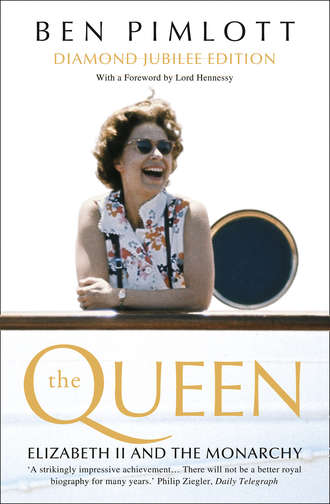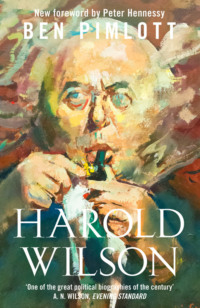
Полная версия
The Queen: Elizabeth II and the Monarchy
It did not take long for the popular newspapers, mixing the lugubrious and the prurient, to see the opportunities. For if the Queen at her Accession had been, in the press imagery, ‘a girl in unrelieved black whom [the King’s] death had brought back from Kenya’s tropic sunshine to the searching chill of Norfolk in mid-winter,’68 she was also a pretty face to brighten the front page. Some of the finest pre-Coronation pictures show her in mourning. There was an erotic splendour to the line of queens and princesses, Elizabeth II at their head, that attended the lying in state in Westminster Hall, ‘like Moslem women,’ as Crossman put it, ‘clothed in dead black, swathed and double swathed with veils so thick that they couldn’t read the Order of Service through them’.69
THE QUESTION of how the Queen should be described in the Proclamation – discussed in Cabinet within hours of the King’s death – was of more than ritual significance. The words chosen, and amended, helped to determine the relationship of the Queen to her realms – and those that would cease to be realms – for many years to come. There was agreement that account needed to be taken of changes. Ministers felt that the traditional formula ‘was not wholly in accord with present constitutional conditions in the Commonwealth.’ The old wording contained anomalous references to ‘Ireland’ – no longer a member state – and to the ‘British Dominions’ which some of the countries so described might not like. It was therefore decided to drop ‘Imperial Crown,’ and include a reference to the Sovereign’s position as ‘Head of the Commonwealth’.70
The problem reflected the growing diversity of the dominions since the Second World War; and it helped to determine the future nature of their relationship with the United Kingdom. Much was to flow from the designation of the Queen as ‘Head of the Commonwealth’ – a title formally acquired by George VI less than a year earlier, through the Royal Titles Bill, which had recognized the ‘divisibility’ of the Crown. Divisibility (the product of diversity) was officially adopted as a principle at the first Commonwealth Prime Ministers’ Conference of the reign in December 1952, when it was agreed that each state should think up a title to express its own relationship with the Crown.
Apart from the United Kingdom, six self-governing nations – Canada, Australia, New Zealand, South Africa, Pakistan and Ceylon – retained the British Monarch as head of state. Three of them felt that ‘Defender of the Faith’ was inappropriate. In all of them ‘Queen of the British Dominions beyond the Seas’ was replaced by ‘Queen of her other Realms and Territories’. Finally, the words ‘Great Britain, Ireland’ in the full title were replaced by ‘the United Kingdom of Great Britain and Northern Ireland’. The changes accelerated a movement away from the notion of the British Monarch as sovereign over ‘dominions’ and towards a personally-based link, in which the Monarch enjoyed a separate identity in each country.71
Advocates of ‘divisibility’ maintained that it was unavoidable and desirable. Not only were the dominions growing apart constitutionally in any case, a sober recognition of political and cultural realities would have the effect of promoting rather than diminishing Commonwealth unity.72 Others argued both that the idea of a ‘personal union’ was absurd, and that the idea of a ‘Head of the Commonwealth,’ who would have any area of discretion distinct from the advice given to her by the ministers of her governments, and primarily the British Government, was a dangerous heresy.
The sharpest proponent of this view was Enoch Powell, a young Conservative MP who had spent much of the war in India, and who – from the start of the new reign – established himself as a lynx-eyed guardian of parliamentary rights vis-à-vis the Crown. Three weeks after the Accession, he wrote to the Prime Minister complaining about the attendance of the Duke of Edinburgh in the peers’ gallery of the House of Commons during a debate – something, he pointed out, a royal consort had not done since 1846 – in the course of which the Duke seemed to make his opinions of what was being discussed unconstitutionally obvious.73 The Government Chief Whip backed the complaint, remarking that the consort had not been ‘exactly pokerfaced,’ and the Duke was privately ticked off.74 Powell returned to the topic of royal interference on many occasions, as the Queen’s titular ‘divisibility’ – which many people in 1952 saw as just an exercise in linguistic tidying – grew in significance as the Commonwealth evolved.
As well as Commonwealth titles, there was also another problem of nomenclature – which touched the Sovereign herself, and more particularly her husband, personally. This was the question of what the Royal Family, and its descendants, should be called.
Конец ознакомительного фрагмента.
Текст предоставлен ООО «ЛитРес».
Прочитайте эту книгу целиком, купив полную легальную версию на ЛитРес.
Безопасно оплатить книгу можно банковской картой Visa, MasterCard, Maestro, со счета мобильного телефона, с платежного терминала, в салоне МТС или Связной, через PayPal, WebMoney, Яндекс.Деньги, QIWI Кошелек, бонусными картами или другим удобным Вам способом.





